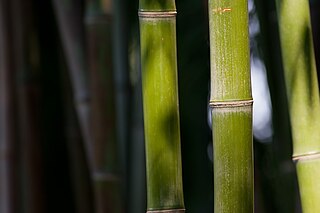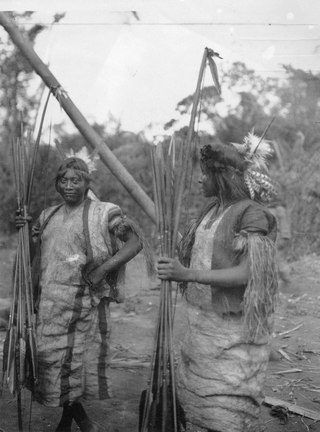
Bamboos are a diverse group of mostly evergreen perennial flowering plants making up the subfamily Bambusoideae of the grass family Poaceae. Giant bamboos are the largest members of the grass family, in the case of Dendrocalamus sinicus individual culms reaching a length of 46 meters, up to 36 centimeters in thickness and a weight of up to 450 kilograms. The internodes of bamboos can also be of great length. Kinabaluchloa wrayi has internodes up to 2.5 meters in length. and Arthrostylidium schomburgkii with lower internodes up to 5 meters in length, exceeded in length only by papyrus. By contrast, the culms of the tiny bamboo Raddiella vanessiae of the savannas of French Guiana are only 10–20 millimeters in length by about two millimeters in width. The origin of the word "bamboo" is uncertain, but it probably comes from the Dutch or Portuguese language, which originally borrowed it from Malay or Kannada.

The Battle of Mactan was fought on a beach in Mactan Island between Spanish forces led by the Portuguese explorer Ferdinand Magellan along with local allies, and Lapulapu, the chieftain of the island, on the early morning hours of April 27, 1521. Magellan, a Portuguese-born commander serving the Spanish Empire who led an expedition that ultimately circumnavigated the world for the first time, commanded a small Spanish contingent in an effort to subdue Mactan led by Lapulapu under the Spanish crown. The sheer number of Lapulapu's forces, compounded with issues on the location and armor, ultimately resulted in a disastrous defeat to the Europeans and the death of Magellan. Surviving members of Magellan's crew continued the expedition under the command of Juan Sebastian de Elcano, who completed the journey in September 1522.

Palawan, officially the Province of Palawan, is an archipelagic province of the Philippines that is located in the region of Mimaropa. It is the largest province in the country in terms of total area of 14,649.73 km2 (5,656.29 sq mi). The capital and largest city is Puerto Princesa wherein it is geographically grouped but administered independently from the province. Palawan is known as the Philippines' Last Frontier and as the Philippines' Best Island.

A blowgun is a simple ranged weapon consisting of a long narrow tube for shooting light projectiles such as darts. It operates by having the projectile placed inside the pipe and using the force created by forced exhalation ("blow") to pneumatically propel the projectile. The propulsive power is limited by the strength of the user's respiratory muscles and the vital capacity of their lungs.

Batrachotoxin (BTX) is an extremely potent cardio- and neurotoxic steroidal alkaloid found in certain species of beetles, birds, and frogs. The name is from the Greek word βάτραχος, bátrachos, 'frog'. Structurally-related chemical compounds are often referred to collectively as batrachotoxins. In certain frogs, this alkaloid is present mostly on the skin. Such frogs are among those used for poisoning darts. Batrachotoxin binds to and irreversibly opens the sodium channels of nerve cells and prevents them from closing, resulting in paralysis and death. No antidote is known.

The Huaorani, Waorani, or Waodani, also known as the Waos, are an Indigenous people from the Amazonian Region of Ecuador who have marked differences from other ethnic groups from Ecuador. The alternate name Auca is a pejorative exonym used by the neighboring Quechua natives, and commonly adopted by Spanish-speakers as well. Auca means 'savage'.
Darts are airborne ranged weapons. They are designed to fly such that a sharp, often weighted point will strike first. They can be distinguished from javelins by the presence of fletching and a shaft that is shorter and/or more flexible. Darts can be propelled by hand or with the aid of a hand-held implement such as a blowgun. They can be distinguished from arrows because they are not used with a bow.

Gawai Dayak is an annual festival and a public holiday celebrated by the Dayak people in Sarawak, Malaysia on 1 and 2 June. Sarawak Day is now celebrated on July 22 every year. Gawai Dayak was conceived of by the radio producers Tan Kingsley and Owen Liang and then taken up by the Dayak community. The British colonial government refused to recognise Dayak Day until 1962. They called it Sarawak Day for the inclusion of all Sarawakians as a national day, regardless of ethnic origin. It is both a religious and a social occasion recognised since 1957.

Palawan, the largest province in the Philippines, is home to several Indigenous ethnolinguistic groups namely, the Kagayanen, Tagbanwa, Palawano, Taaw't Bato, Molbog, and Batak tribes. They live in remote villages in the mountains and coastal areas.

Sibat is the Filipino word for spear, used as a weapon or tool by natives of the Philippines. The term is used in Tagalog and Kinaray-a. It also called bangkaw, sumbling or palupad in the islands of Visayas and Mindanao; and budjak among Muslim Filipinos in western Mindanao and the Sulu Archipelago.

The Tagbanwa people are one of the oldest ethnic groups in the Philippines, and can be mainly found in the central and northern Palawan. Research has shown that the Tagbanwa are possible descendants of the Tabon Man, thus making them one of the original inhabitants of the Philippines. They are a brown-skinned, slim, and straight-haired ethnic group.
Arrow poisons are used to poison arrow heads or darts for the purposes of hunting and warfare. They have been used by indigenous peoples worldwide and are still in use in areas of South America, Africa and Asia. Notable examples are the poisons secreted from the skin of the poison dart frog, and curare, a general term for a range of plant-derived arrow poisons used by the indigenous peoples of South America.

Blood compact was an ancient ritual in the Philippines intended to seal a friendship or treaty, or to validate an agreement. The contracting parties would cut their hands and pour their blood into a cup filled with liquid, such as wine, and drink the mixture.

Antiaris toxicaria is a tree in the mulberry and fig family, Moraceae. It is the only species currently recognized in the genus Antiaris. The genus Antiaris was at one time considered to consist of several species, but is now regarded as just one variable species which can be further divided into five subspecies. One significant difference within the species is that the size of the fruit decreases as one travels from Africa to Polynesia. Antiaris has a remarkably wide distribution in tropical regions, occurring in Australia, tropical Asia, tropical Africa, Indonesia, the Philippines, Tonga, and various other tropical islands. Its seeds are spread by various birds and bats, and it is not clear how many of the populations are essentially invasive. The species is of interest as a source of wood, bark cloth, and pharmacological or toxic substances.

Antiarins are cardiac glycoside poisons produced by the upas tree. There are two closely related forms, α-antiarin and β-antiarin. The two share the same aglycone, antiarigenin, but differ in the sugar group that is attached to it.

Tolor or Telenga is a traditional quiver in which the Dayak hunters carry the poisonous darts for Sumpit (blow-pipe), originating from Borneo.

Bambooworking is the activity or skill of making items from bamboo, and includes architecture, carpentry, furniture and cabinetry, carving, joinery, and weaving. Its historical roots in Asia span cultures, civilizations, and millennia, and is found across East, South, and Southeast Asia.

Tubâ is a Filipino alcoholic beverage created from the sap of various species of palm trees. During the Spanish colonial period, tubâ was introduced to Guam, the Marianas, and Mexico via the Manila galleons. It remains popular in Mexico, especially in the states of Colima, Jalisco, Michoacán, Nayarit, and Guerrero. Tubâ was also introduced to the Torres Strait Islands of Australia in the mid-19th century by Filipino immigrant workers in the pearling industry.
Kaong palm vinegar, also known as irok palm vinegar or arengga palm vinegar, is a traditional Filipino vinegar made from the sap of the kaong sugar palm. It is one of the four main types of vinegars in the Philippines, along with coconut vinegar, cane vinegar, and nipa palm vinegar. It is usually sold under the generic label of "palm vinegar".

Wanám,, were a group of Amerindians once native to the region of southern Rondônia in Brazil. They lived on the Cautarinho, Sao Miguel and Manoel rivers near their confluence with the Guaporé. Around 1914 there were 300 Wanám. The rubber booms of the twentieth century destroyed the tribe because of the violence and diseases brought in by neo-Brazilians. The surviving Wanám went to live with neighboring groups Kabixí living on the São Miguel River. Although the Wanám people did not survive, their language did, at least among the Kabixí Indians.



























